The UK's deer population is believed to be at its highest level for 1,000 years, with some two million deer in our countryside and semi-urban areas. As farmers and conservationists become ever-more concerned at the impact that deer have on crops and wildlife, scientists argue that an increase in culling levels is essential.
Here is our expert guide to deer culling, including why and where it is done and the six species of deer found in the UK.

How many deer are there in the UK?
There is an estimated population of between 650,000 and 2 million deer in the UK (The Mammal Society, DEFRA) comprising 6 different species: red, roe, fallow, sika, muntjac and Chinese water deer. Deer numbers are thought to be at their highest level for 1,000 years.
Numbers may have doubled since 1999, according to the Deer Initiative (which promotes the sustainable management of wild deer) and other sources. As farmers and conservationists become ever-more concerned at the impact that deer have on crops and wildlife, scientists now argue that an increase in culling levels is essential.
Each year as many as 350,000 (DEFRA 2009) are culled. This occurs on private estates, parkland, woodland, farmland, and specialised habitats such as heathland. Deer are also stalked and shot for food within season.
Deer management has recently received significant public interest, with the annual cull within London’s Royal Parks creating anger and opposition. In Scotland meanwhile, a petition calling for a complete cull of red deer on the island of South Uist drew national attention.


What is the problem with deer?
- £4.5m: The cost of damage caused by deer to plantations and other commercial woodlands, according to the Forestry Commission of Scotland.
- 8,000 hectares: The area of woodland with Site of Special Scientific Interest (SSSI) status that is currently in ‘unfavourable’ or ‘recovering’ condition due to deer impacts. This is likely to represent a fraction of the real picture, according to the Parliamentary Office for Science and Technology (POST). “Deer can affect the age diversity of a woodland, resulting in a fall in numbers of species, and strip bark off older trees, which kills them,” says Paul Wilkinson of the Wildlife Trusts.
- 74,000: The number of road traffic accidents a year involving deer, which kill between 10-20 people, according to the British Deer Society.
- £4.3m a year: The cost of deer damage through eating and trampling crops, according to Defra, with the greatest damage on cereal crops in east and south-west England.
- 50%: The decline in woodland bird numbers where deer are present, according to the University of East Anglia’s Dr Paul Dolman: “Deer will eat the understorey and so the coppices, for example, lose their shrub layer. That can be a problem for nightingales and other long-distance migrants, such as willow warblers, chiffchaffs and blackcaps.
- Large populations of deer are likely to be contributing to the abundance of ticks, parasitic insects that can carry diseases such as Lyme and TBE (tick-born encephalitis) that are a threat to public health. Deer may also carry parasites or diseases such as foot-and-mouth and bluetongue which are a threat to livestock.
Why are there so many deer in the UK?
Red and roe deer are native to the UK, while Normans brought fallow with them to hunt. These have been supplemented by escapees from introduced populations of Chinese water deer, muntjac and sika. There are other reasons for population increase, including:
Protection
With widescale protections (Deer Act 1991, Wildlife & Countryside Act 1981, Hunting Act 2004), and geographical areas where control is less rigid, numbers of deer can increase rapidly.
Lack of predators
Historically, deer would have been predated by the wolf, lynx and bear (all now extinct in the UK) and hunted by humans for food and clothing. With no natural predators, deer numbers are likely to exceed natural levels. Richard Bunting (Rewilding Britain) explains, “Top predators drive ecological processes from the top of the food chain to the bottom in an important process known as a trophic cascade. Living systems can’t function properly where large animals are missing.”
Dr Paul Dolman of the University of East Anglia, “[Historically], deer wouldn’t have stood a chance in the countryside because people were hungry. Now people aren’t living off the land so deer are much more likely to survive.”
Good habitat for deer
“Everything is in the deer’s favour,” says Peter Watson of the Deer Initiative. “Forest cover has increased and farmers grow crops all year round.” They thrive on farmland where the planting of winter crops offers a food source during otherwise lean months, and milder winters, resulting from climate change, allow increased fecundity.

Does Britain need an intensive universal cull of deer?
A University of East Anglia study has suggested localised, targeted culls – rather than a widespread cull – of up to 53 percent of muntjac and 60 percent of roe deer might be necessary. “We need a strategic objective. All the focus seems to be on areas where deer are out of control, but that leaves deer free to cause problems in other areas in the future,” says Dr Paul Dolman.
The Deer Initiative also accepts that culling may be necessary. Chief executive Peter Watson says: “As long as numbers continue to increase, we have to accept there are going to be more of these hotspots. There’s a wider question of just how many deer we can live with.”
The National Gamekeeper’s Organisation (NGO) agrees on the need to cull more deer in certain areas. “ The way to cull deer is on a regional and local basis, with gamekeepers and recreational stalkers liaising with one another,” says Charles Nodder of the NGO.

Mark Nicolson, of the British Deer Society, opposes a widespread cull but agrees culling is needed in some areas: “There are large parts of the UK where the deer population is in harmony with the environment, but there are places where it is not. We’re one of the few animal charities that supports culling. We need to focus on management – the alternative for many deer is a lingering death.”
The Wildlife Trusts believe culling should be done as a last resort and says that fencing can help in many cases. “The deer is an iconic species, something that is a thrill to get a glimpse of,” says the Trusts’ Paul Wilkinson. “But there’s a need to introduce some management. Nobody goes into nature conservation to kill things. But we need to be grown up about it. Both culling and fencing are valid, but shooting should not be seen as the first option and it should be underpinned by science. We are trying to promote a wide abundance of wildlife and if one species becomes overly dominant then we are not achieving that. We have to recognise that deer no longer have a natural predator.”
How are deer culled?
Deer are culled within specific dates, to protect females with dependent young and males that are still developing antlers. The close season varies between species and sexes, although muntjac are not included (and have no restrictions) as they breed throughout the year. In situations where animals are injured or diseased, culling is permitted outside of the given dates.
The British Deer Society (BDS) guidelines aim to replicate a natural selection process, so weaker animals or stags injured during the rut, will be singled out. Animals are shot, using a high velocity rifle for which the bearer will require a licence. Mark Vasey-Thompson (Wildlife Manager) explains, "99% of my time is spent watching deer, not shooting them. Gun safety and the humane dispatch element are of the highest importance, but if something should go wrong, I have tracking dogs and a contingency plan in place to ensure the animal is followed up and dispatched as quickly and humanely as possible."
But there are plenty of people opposed to the methods employed. In response to the shooting of deer in the London Parks, Elisa Allen of PETA said, “These methods are not only ineffective but also cruel, as it can be difficult for hunters to get a clear shot and deer often endure slow, horrifyingly painful deaths.”
What are the alternatives to deer culling?

Fencing is an obvious and locally effective protection against deer damage to crops, trees and valuable habitat, but it is costly and requires specialist construction. Deer can jump most standard fence heights and barbed wire can catch a trailing leg and cause serious injury. Other materials such as netting, or the cords used in electric fencing, may cause animals, especially antlered males, to become entangled.
Rewilding groups urge the reintroduction of extinct predators, Richard Bunting (Rewilding Britain) saying, “A natural balance between herbivores and carnivores brings wide-ranging benefits for habitats, species and entire ecosystems.”
It is a method that has proved successful in the US with the reintroduction of wolves to Yellowstone National Park, but a lack of territorial space and abundance of alternative food, such as pheasants and rabbits, would mean deer culling in the UK was still necessary. Farmers would also be concerned about loss of livestock, with Environment Minister Therese Coffey dismissing the proposal at this year’s NFU Conference, insisting “We just don’t need to (reintroduce lynx and wolf) and we won’t do.”
Elisa Allen (PETA) suggests a more natural approach, restricting available food so that deer self-regulate. She says, “Deer are known to control their own numbers, even reabsorbing a foetus if food supplies are low.”
But Charles Smith-Jones (BDS) counters, “Although reproductive rates can be affected by poor food availability, this state will only be reached once natural resources have been significantly depleted. Other effects on a deer population at such a point of over-population might include unacceptably high levels of stress, malnutrition and disease.“
Trials involving fertility control are ongoing and such a method is championed by several online campaign groups. This might work for enclosed colonies but would be difficult to administer on a wider scale. The BDS state that, “Where immunocontraception has been used on populations of wild deer, it has taken several years for the population growth to slow down.” The organisation is keen to review development in that area, however, and is open-minded to any viable options.


